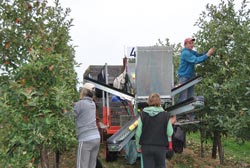Fruit production and viticulture: Farms and mechanization are growing worldwide

Apple harvest in a modern apple orchard in Grimma, Saxony. This orchard as well as viticulture farms in Rheinhessen were visited by the participants of the agri benchmark conference.<br><br>(c: Thünen Institute)<br>
The trends are the same, even in clearly different farm structures and production systems: that’s how the experts from seven countries attending the first conference of the agricultural economic network “agri benchmark Horticulture” held from Sept. 23 -27, 2013 at the Thünen Institute of Farm Economics in Braunschweig see it. The goal of the conference was to compare production structures and costs.
The basis for this are models of typical fruit and viticulture farms which were defined by crop experts and producers. The professionals provide information which full time farms with their production systems, practices and costs are typical for each production region.
At the moment the European farms are on average still significantly smaller than those in the southern hemisphere. In Italy – Europe’s second largest apple producer – a typical farm is just between 2.5 ha (in South Tirol/Trentino) and 5 ha (Emilia Romagna).
Germany has a broad range of typical farm sizes in the most important production regions, but there are farms on Lake Constance with 15 ha and on the lower Elbe in the Altes Land with 20 or rather 40 ha, in the Sachsen Elbe region with even about 150 ha, in which the future development becomes evident. In contrast in the South African Cape Region, farms with 80 to 120 ha of apple crops are typical, and in Chile the span is from 25 to 80 hectares. The situation in viticulture is similar.
Apples and grapes are labor intensive crops. A comparison of the production and cost structures shows: how the farms develop is largely related to whether laborers are available and what they cost. In Europe the mechanization is widely developed due to the high labor costs. But also in Chile and in South Africa interest is growing on labor saving technologies due to increasing salaries: alone last year the legal minimum wage in South Africa was raised by 50 percent.
In Chile fruit farms compete with the currently flourishing mining industry for laborers, so that seasonal workers earn about 30 % more than they did two years ago. The larger a farm is, the more strongly mechanization and rationalization pay off, thus further speeding the development. The structural transformation is thus comparably intensive in all production regions for both crops, with the trend progressing to increasingly larger farm structures.
A multiple-day excursion led, among other things, to Saxony to visit the largest German apple farm in Grimma and to the viticulture farms in Rheinhessen. The use of innovative technology to save labor was evaluated by participants with a look at the possible development in their own countries. “If the wages continue to increase this dramatically, our producers hardly have a choice but to invest in mechanization,” said Nando Baard from the South African fruit growers’ organization, Hortgro.
During a visit to a wine producer cooperative the conference participants could be convinced that in modern wine production cost savings with the use of technology and quality are not mutually exclusive. Prof. Hoffmann from Geisenheim University explained; “Through the use of modern technology in the cellars, the constant monitoring of the production process and the good coordination among the grape farms in the past years the quality of bulk wines has improved significantly.”
The network agri benchmark Horticulture is a new part of the established and successful network association agri benchmark, in which standardized methods are used for worldwide comparisons of production systems, their profitability, driving forces and perspectives. The results of the first conference show that also for fruit and viticulture annual analyses of the profitability are needed in order to understand the farm structures and competitiveness of different countries for apple and grape production.
Further information can be found under: http://www.agribenchmark.org/horticulture.html
Media Contact
More Information:
http://www.agribenchmark.org/horticulture.htmlAll latest news from the category: Agricultural and Forestry Science
Newest articles

Combatting disruptive ‘noise’ in quantum communication
In a significant milestone for quantum communication technology, an experiment has demonstrated how networks can be leveraged to combat disruptive ‘noise’ in quantum communications. The international effort led by researchers…

Stretchable quantum dot display
Intrinsically stretchable quantum dot-based light-emitting diodes achieved record-breaking performance. A team of South Korean scientists led by Professor KIM Dae-Hyeong of the Center for Nanoparticle Research within the Institute for…

Internet can achieve quantum speed with light saved as sound
Researchers at the University of Copenhagen’s Niels Bohr Institute have developed a new way to create quantum memory: A small drum can store data sent with light in its sonic…





















